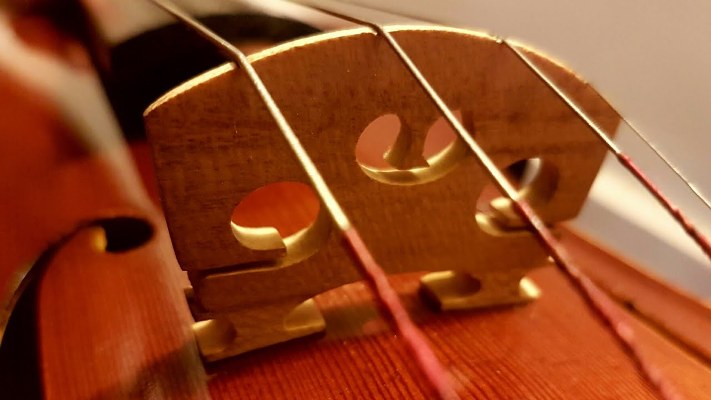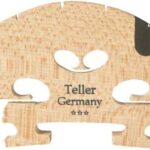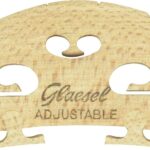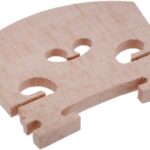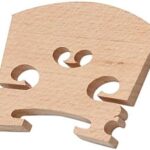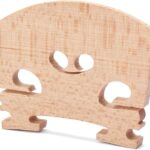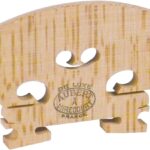A violin’s tailpiece, posts, chin-rest and pegs are all important components that work together to make the violin function. One of the parts we’re focusing on this time is our violin bridges. Violin bridges support the violin strings, which is why they are so important to any violin player.
A violin is an instrument that produces sound when a bow, attached to its strings by means of a bridge, is drawn across the instrument’s frets. It also helps transmit the vibration of the strings to the soundboard of the violin. This ensures that you would produce a good sound. As a violinist; it is then important to search for high-quality bridges.
Top Violin Bridges Review
It can be hard to know which violin bridge is right for you. We have broken down the pros and cons of the ten best bridges so that you can make the best possible decision. Now, it’s your turn to decide what type of bridge grows and develops with your skill level.
Let’s compare these violins! Here are ten of the best ones and what you should get. Which is your favorite?
1. SKY Fitted Full Size Violin Maple Bridge
Perfect for beginners, this violin bridge has the perfect fit for virtually any violin. Because it is a custom-made piece, you get to choose from 3 different available colors. Enjoy the quality at a price that won’t break the bank!
The violin string fits nicely within the groove and also comes with a generic cut, making it easily compatible with most instruments. The cost of a SKY Fitted Full Size Violin Maple Bridge is $10.
2. Other Music Stand
One of the best violin bridges is the Other Music Stand. This is a semi-fitted violin bridge made by the brand Aubert, Germany.
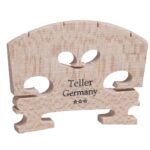
It gives the impression that it will last a long time. The cost Other Music Stand is from $15.50.
3. Violin Aubert Semi-Fitted Bridge
Violin bridges come in a variety of shapes and sizes. In this case, the bridge is a bit more delicate than others because it consists of air-dried Bosnian maple.
You are in a safe place to set up your violin bridge. All you need to do is to sand paper the top of the violin. Then, slide a bridge across the sand paper in a single direction. The cost Violin Aubert Semi-Fitted Bridge is from $19.90.
4. Glaesel Violin Bridge (GL33524M)
The GL324524 is also a great violin bridge which can be used for a non-standard and highly sloped violin that has an insufficient amount of wood to craft one specifically for the make and model of instrument.
Installing the app is easy and it can be done without any hassle. It saves a lot of time and effort from the often tedious process of browsing and selecting other apps. The cost Glaesel Violin Bridge (GL33524M) is from $36.
5. Lsgoodcare Violin Maple Bridge
We think the Lsgoodcare Violin Maple Bridge is a great option for any violin, and you can find out more information about it on our site. We love how it works with your violin without any installation issues.
M-63 stringer bridges are an affordable option for stringing your violin. They work with standard tuning and are made of a sturdy, reliable material that will last you years. The cost Lsgoodcare Violin Maple Bridge is from $10.
6. Cremona VP-202 Violin Bridge
One other good product one can choose would be the Cremona VP-202 violin bridge, made of seasoned northern maple. It has a smooth, lightly figured construction.
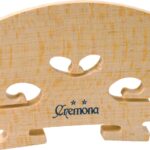
7. Timiy Violin Maple Bridge
The Timiy Violin Maple Bridge emits a tone that is rich and deep. It is pre-cut to size and tapers smaller where needed. It’s easy to install with a screwdriver.
Because it has 6 pieces in each of the 12 sets, it can be a good choice for your violin bridge replacement. The cost Timiy Violin Maple Bridge is from $6.70.
8. Emoonland Fine Grade Maple Full Size Violin Bridge
The Emoonland Maple Violin Bridge is a fine piece that can be fitted onto the instrument nicely.
Made of maple wood, its quality makes it perfect for fitting into your violin. This set includes five pieces of string in different sizes so you can shape them to fit your guitar, violin, or any other stringed instrument. The cost Emoonland Fine Grade Maple Full Size Violin Bridge is from $6.60.
9. Aubert VB-8A Old Luxe Violin Bridge
This violin bridge is made out of carefully dried, aged European maple wood. You’re certain that it will last long because it’s been made through proprietary steps.
You’re also ensured that it adds a bright and rich tone to your violin. One of the best options for violins, cellos, and other string instruments. Requires final assembly once bought. The cost Aubert VB-8A Old Luxe Violin Bridge is from $35.88.
10. Violin Bridge Teller Germany Bridge
Are you looking for the best violin bridges that you can buy online? The Violin Bridge Teller Germany Bridge is a nice pick because it is made of maple wood, which is strong and sturdy.
This allows you to enjoy playing your violin with ease. This product comes in sets of 3 pieces. The cost Violin Bridge Teller Germany Bridge is from $20.50.
What Makes a Violin Bridge Best
If there’s only a couple of deciding factors, it might not be that good. Wood often has a major effect in helping to create sounds. It is highly recommended that a bridge of maple syrups are used.
Maple is a popular option for guitar bridges. It helps to control and enhance the vibrations of the strings and can be found on some of the best instruments.
Maple is a very effective material for building bridges because not only is it versatile, but it also provides both thinness and strength. Some well-known companies have been crafting reliable maple bridges for many years that can enhance your sound quality and help achieve an ideal tone.
The setup of your violin and the design of its bridge play a big role in determining the type of music you’ll make with it. Playing on certain conditions produces a certain sound. For example, playing on an open, wide bridge (the curvature of which explains the placement and tension for each individual string) will produce a resonance that would make traditional folk music sound like finger. A good bridge will have a height that is best suited to not only lift the strings and separate them, but also to give you some pace and coordination while you’re playing.
A bridge with any degree of curvature will not result in deep tones that hit the target note squarely. Most experts agree that the easiest way to change the sound of your violin and to improve your skill level is to try out different bridges.
The brand of the bridge is important because it does take a certain amount of expertise to create a bridge that will improve the violin. The list of architects who are considered to be the best bridgebuilders includes a few names:
- Aubert – Joseph Teller
- Glaesel
- Despiau
There are plenty of great brands that have always been around, but the three mentioned above often receive the most attention for their time-tested products.
There are a lot of violin bridges you can find on the market, which might make choosing the right one difficult. A violin bridge will have unique features and you’ll need to know that in order to pick one that suits your needs best. We have found some of the best violin bridges on the market so you can buy with confidence.
We also talked about their features, which will help you identify the product that best suits your preferences.
What to Look for in Violin Bridges
When you’re about to buy a violin bridge, it’s important that you try on the instrument before purchasing. This way, you can ensure that it is compatible with your violin and will offer the support needed.
Whether you’re looking for a pair of violin bridges or just trying to learn more about what features are right for you, this article will help guide you through. Here are four crucial components that signify durability and find out how these can be the difference between a good and bad bridge in your repertoire.
Thickness and Curvature
Consider the thickness of the bridge in your speakers, as that can make a significant difference in how sound is produced. The bridge of a violin is thicker on the bottom than those on the top. This is because the top layer transmits vibration much more easily than the bottom one. In this case, the violin would sound weak and soft.
You don’t want a very thin bridge since it could crack under string pressure. Stringharps might sound cool but they may not be able to carry the strings under pressure. You have to choose a bridge that is right for you. It’s not necessary that the other bridges will be too thin.
The shape of the violin bridge is important for its aesthetic appeal. Make sure that it is not flat on one or both ends. Bridges are usually stronger when they’re curved. This is because they can provide support and withstand the downward pressure that vibration will bring. Look for the curved edge of your throat and the clear lumps on either side.
Fit and Angle
You also need to ensure that the feet of the violin bridge would fit perfectly. The piece of wood on top of the instrument is called a bridge, and it would connect to the strings.
There should be no space between the body of the violin and its foot or anywhere else, to maximize the violin’s response time. The space under the bridge can only reduce the sound transfer to the body.
The back of the violin bridge should have an angle of 90 degrees to the top of the violin. That is one feature to consider when looking for a new bridge. Also, it’s important to think about how large or small your instrument is.
When you play the violin, before playing a note, make sure that one side of the violin is facing up and the other down. If you turn the handle one way or another, the bridge has a higher chance of breaking at any moment. This can also damage the top of your violin.
Gardening. You should keep in mind the features we just talked about, as well as other things to consider when you’re looking for the best violin bridge out there. The features mentioned by us are essential so you can gauge the quality of the products you’re going to buy.
Conclusion
Whether or not you plan to play music, having a high-quality violin case is important so that you won’t be hurt while playing. A violin bridge is a piece of material used to cover the string of your instrument. Different types of bridges are created with different purposes in mind, and these features can be found on quality products.
AI writing assistants have a lot of functions that can be used to support any strings you have. They will not only help you become a better musician in the long run, but they are also a great investment for your business.
FAQ for Best Violin Bridges
What is a violin bridge?
A violin bridge is the piece of wood that supports and connects the strings at the top of a violin. It is also known as a bridge pin.
The violin bridges are made of wood and they are glued to the bottom of the instrument. Some bridges have a metal ring that is used to raise or lower the pitch.
What are the best violin bridges?
Violin bridges are an important part of the violin, and they are either made of ebony or maple. It is important to have a well-made bridge so that it can last for a long time.
The best violin bridges are typically made of maple wood. Maple wood is considered to be one of the best materials for making bridges because it is light, durable, and has good acoustic properties.
The most common types of bridges used in violins are the Ebony bridge and the Maple bridge. The Ebony bridge is typically seen as more traditional while the Maple bridge has been gaining popularity in recent years due to its durability and sound quality.
What are the different types of violin bridges?
Violin bridges are the small pieces of wood that connect the strings to the bridge of a violin.
There are four types of violin bridges:
- The Italian bridge, also called a “square” or “fiddle” bridge.
- The French bridge, which is made in a triangular shape and has three arms.
- The German bridge, which is made in a trapezoidal shape and has only two arms.
- The Spanish bridge, which is made in an oval shape and has four arms.
Can a violin bridge be too thin or thick?
A violin bridge is the piece of wood that connects the strings to the body of a violin. The thickness of a violin bridge affects the tone and sound quality.
The thickness of a violin bridge can be too thin or too thick, but it is difficult to determine which one is better.
The thickness of a violin bridge depends on factors such as:
- The size
- The type and quality of wood used
- The type and quality of glue used to hold together the wood
Is there a difference between a violin bridge and a bow bridge?
The violin bridge is the part of the violin that connects the front and back of the instrument. It has a small, thin piece of wood that sits on top of the strings. The bow bridge is a part of the bow that connects to the frog, which in turn connects to the stick.
The violin bridge is made up of two pieces, one on either side of the strings. The bow bridge is made up of three pieces: a top piece and two bottom pieces.
A violin bridge has small, thin pieces that sit on top of each string while a bow bridge has larger pieces that sit on top of each string and are connected by thinner strips.
Does a violin bridge really make a difference?
Yes, violin bridges really do matter. They can affect the sound, who knows how that works haha. Annoying things like how the wood was seasoned or how thick it is or even where they were cut from, who cares?
Additionally, many older bridges don’t have enough curve or bow height. It can be difficult to play a single note rather than a double stop or chord.
What does the violin bridge do?
A bridge is one of the major components in a violin that allows the strings to vibrate and makes all the sounds. A bridge lifts strings up and guides them over to a tailpiece, which holds the vibration. The vibration then travels through stringed pillars to their soundbox, where it’s amplified for everyone else to hear!
How much does it cost to replace a violin bridge?
Price of a bridge can vary depending on condition and size. A bridge tends to cost anywhere from $10 – $80 or more. You will generally pay around $25 for refitting or replacing a warped one, so an investment may be worth it if you need something just as good but bigger.
You can expect a higher price tag for something that’s worth it.
How long does a violin bridge last?
Bridges can last a lifetime with proper care. Look after your bridge and it will last as long as your instrument! You’ll often find vintage instruments that have perfect bridges, even if they’re older.
Bridges can naturally become warped over time, so it’s important to be sure that your bridge is still at a 90-degree angle. If not, it is time to replace or repair. Keep an eye on the line in the varnish that shows where the bridge typically sits. If you see signs of movement, readjust that particular bridge accordingly.
Can a violin play without a bridge?
It is not possible to play a violin without a bridge. The bridge is needed to lift the strings up above the fingerboard and transmit the vibrations to the belly of the instrument. If there’s no bridge, then it’s only the dull soundboard that remains.
How do I know if my violin bridge is in good condition or not?
A violin bridge is the piece of wood that connects the strings to the sound post. It is important to make sure that it is in good condition and not cracked. The bridge should be straight, even, and have no gaps. You should also check the sound post for cracks or chips. If it’s in good condition, then you’re all set!
There are a few things you can do to test your violin bridge’s condition before playing a note on it:
- Hold your violin up to a mirror and look for cracks or gaps in the bridge or sound post.
- Press down on one of the strings with your finger and watch as the string moves towards you. If there’s any gap between your finger and where it meets with the bridge, then there might be a crack or chip in that spot.
What are the best violin bridges for beginner violin players?
The bridge is the piece of wood that connects the strings of a violin to the body of the instrument. Different bridges have different shapes and sizes.
The best violin bridges for beginner players are those that have a small bridge plate and are made from maple or spruce wood. They also need to be adjustable, so you can tune your violin easier.
What is the difference between a violin bridge and a tailpiece?
A violin bridge is the part of the violin that connects the strings to the body of the instrument. It is made of wood and metal and it also has a string length adjuster.
A tailpiece is a piece of equipment that makes it easier to play on a violin. It comes in different shapes and sizes, but it’s generally attached to one end of the bridge.
How can I keep my violin bridge from falling off?
The violin bridge it is used to hold the strings in place and allows for easy playing. The bridge must be glued in place to make sure that it doesn’t fall off during playing.
One way to keep it from falling off is by using a clamp. This can be done by wrapping a string around the clamp and then tightening it down with pliers or vice grips. Another option is using a rubber band, which can be wrapped around the bridge and then tightened down with pliers or vice grips as well.
What are the benefits of using a bridge on a violin?
The benefits of using bridges vary depending on the type of bridge being used. Some bridges are more stable than others and some are designed for specific purposes like playing in an orchestra or soloing.
Bridge types:
- Fixed Bridge: This type is usually glued onto the fingerboard and has no moving parts. It is usually used when playing in an orchestra or soloing.
- Adjustable Bridge: This type has a movable bridge that can be adjusted by pressing on it with one’s fingers and sliding it along the fingerboard to change its length, as well as by bending it up or down at its ends, which changes its pitch.
What should I do when I pick up my violin and notice that it doesn’t have a bridge on it?
This is a question that many violinists ask themselves when they notice that their violin doesn’t have a bridge. However, you should never try to fix your instrument yourself because you could damage it in the process. Instead, contact your local music shop or repair shop to get help with the bridge.
How much violin bridge cost?
A violin bridge it comes in different sizes and shapes, and the cost varies depending on what type you buy. In general, a bridge will cost anywhere from $10 to $50.
